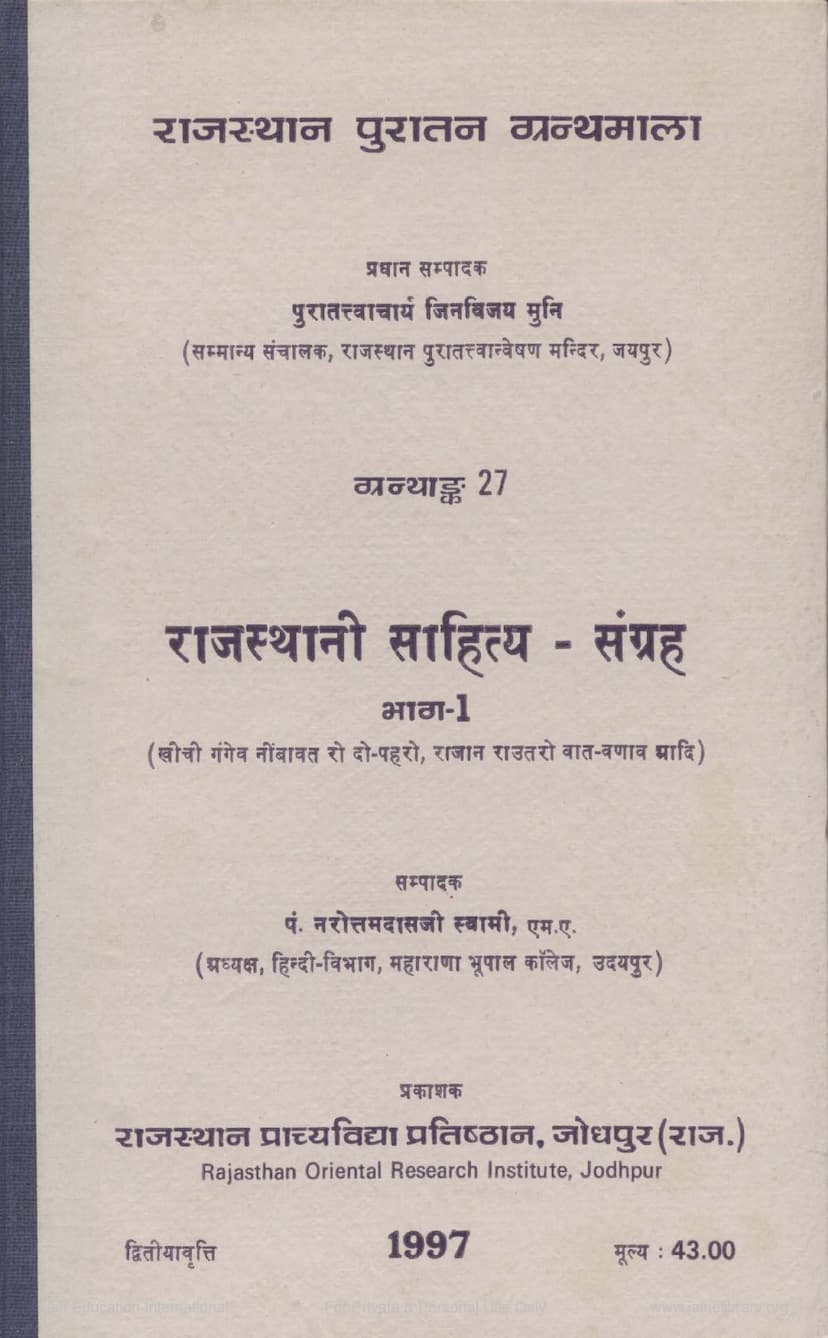Rajasthani Sahitya Sangraha 01
Added to library: September 2, 2025

Summary
Here is a comprehensive summary of the Jain text "Rajasthani Sahitya Sangraha – Bhag 1," based on the provided pages:
Book Title: Rajasthani Sahitya Sangraha – Bhag 1 Author: Pt. Narottamdasji Swami Publisher: Rajasthan Prachyavidya Pratishthan, Jodhpur Series: Rajasthan Puratan Granthamala, Granthank 27
Overview:
This book, the first volume in a series dedicated to Rajasthani literature, aims to present significant ancient prose compositions of the Rajasthani language. It is a compilation of three descriptive prose works that shed light on the lifestyle and ideals of Rajput warriors and the nuances of Rajasthani culture. The collection is presented to scholars and enthusiasts of Rajasthani literature and culture.
Key Contents and Themes:
The collection includes the following three prose works:
-
Khichi Gangev Nimbawat Ro Dopaharo (खीची गंगेव नींबावत रो दो-पहरो):
- This is described as a beautiful prose-poem with captivating descriptions that deeply affect the reader.
- It details the daily routine of Gangev (also known as Gangav), the son of Nimbavat of the Khichi lineage, and his companions over a single day.
- The work is titled "Dopaharo" or "Be-Paharo" because it prominently features the description of the afternoon.
- It provides excellent insight into the life and living standards of Rajput feudal lords during the late medieval period. The text includes vivid descriptions of the monsoon season and the preparations and activities of Gangev and his retinue.
-
Ramdas Veravat Ri Akhadi Ri Vaat (रामदास वैरावत री आखड़ी री वात):
- This work focuses on Ramdas Rathod, son of Veraji, son of Rao Ridhmal (Ranmal) of Marwar. Ramdas was a renowned warrior of his time.
- The "Vaat" (a type of prose narrative) enumerates his 19 epithets (virud) and 84 vows or pledges (aakhadi/paakhadi).
- "Paakhadi" is explained as a solemn vow or undertaking. Ramdas had taken 84 such vows.
- These epithets and vows highlight his exemplary character and valor. The narrative includes a story of his prowess, illustrating his commitment to his pledges.
-
Rajan Raut Ro Vaat-Banav (राजान राउतरो वात-वणाव):
- This is a collection of descriptive passages suitable for various occasions and narratives. Such descriptions were commonly used by storytellers.
- It is compared to similar descriptive works found in ancient Jain scriptures and other literary traditions like Jyotirishwar's "Varna-Ratnakar" (15th century) and Sanskrit texts on poetics ("Kavi-Shiksha").
- The work belongs to the tradition of "Vagvilas" (play of speech) or narrative poetry. While the composition itself might not be ancient, its descriptions draw from older traditions.
- A notable feature of this work, distinguishing it from mere collections of descriptions, is that these descriptions are woven into a coherent narrative, making it a beautiful prose-poem. The descriptions, especially those of seasons, show the influence of Mahakavi Prithviraj Rathor's "Kriman-Rukmani Ri Veli" and have similarities with the descriptions in "Dopaharo." The text includes detailed descriptions of cities, palaces, seasons, festivals, daily life, and the grandeur of kings and their courts.
Editorial and Scholarly Contributions:
- Chief Editor: Puratatvacharya Muni Jinavijay (Director, Rajasthan Archaeology Department, Jaipur).
- Editor: Pt. Narottamdasji Swami, M.A. (Head, Hindi Department, Maharana Bhopal College, Udaipur).
- The book includes two essays by the renowned researcher and scholar Shri Agarachand Nahata, which enhance its utility and provide a context for Rajasthani prose poetry and descriptive collections.
Historical Context of Rajasthani Prose:
- The preface highlights the ancient tradition of prose writing in Sanskrit literature, mentioning works like Dandi's "Dashkumar Charit" and Bana's "Kadambari."
- It notes that Hindi prose literature gained prominence from the latter half of the 16th century, while Rajasthani and Gujarati prose traditions are older.
- Rajasthani prose literature is vast, with thousands of historical chronicles (khatas), narratives (vata), and prose pieces (vachanika). Many Sanskrit prose works were also translated into Rajasthani.
- Rajasthani narratives (Vata) offer a unique portrayal of Rajasthani culture, depicting the daily life, markets, gardens, festivals, wars, and sports of the people with vivid detail.
- The essays by Agarachand Nahata delve into the tradition of Rajasthani prose poetry, distinguishing various forms like "Davait" and "Vachanika," and tracing their development from ancient times to the modern era. They also discuss the influence of Sanskrit literary conventions and the unique characteristics of Rajasthani prose, such as the use of rhyme ("tukanta").
Significance:
"Rajasthani Sahitya Sangraha – Bhag 1" is a valuable resource for understanding the rich and diverse prose tradition of Rajasthani literature. It showcases the descriptive prowess, cultural insights, and historical narratives that are integral to Rajasthan's literary heritage. The inclusion of detailed descriptions of royal life, warfare, natural beauty, and cultural practices provides a vivid picture of the past. The book emphasizes the importance of preserving and studying these ancient texts for future generations.